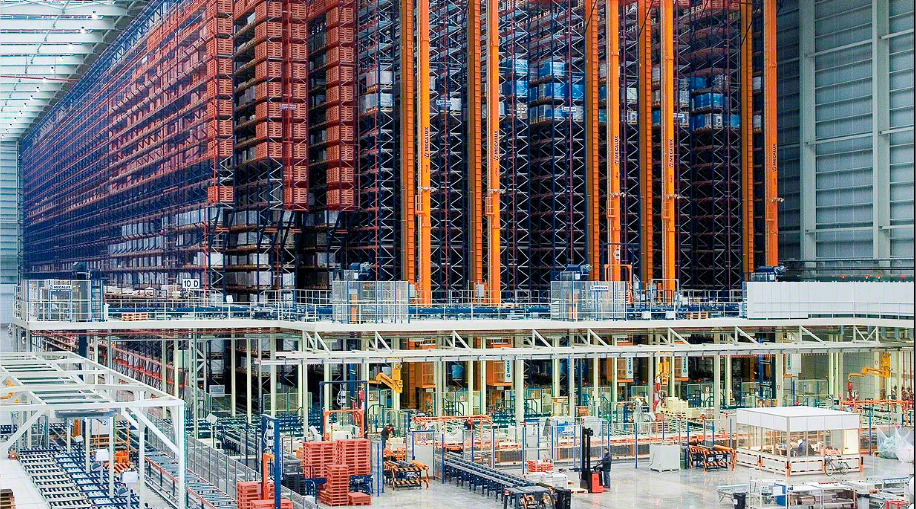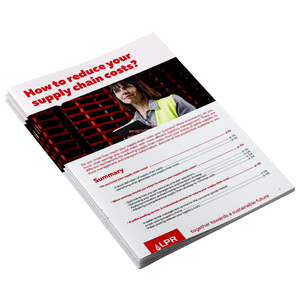Companies in the FMCG sector regularly have to deal with sector-specific challenges, particularly in logistics management. Tight deadlines, ever-increasing stock levels, distance to suppliers, traceability and security are just a few.
Without supply chain optimisation within the FMCG industry, the cost implications can be enormous, to the point of jeopardising profitability!
Stock that doesn’t flow quickly can easily become dead stock and a net loss to the company. Equipment failure, such as a cold room malfunction, can cause the entire supply chain to break down.
It is therefore vital to improve and refine the supply chain as much as possible, and the need for innovation is constant. The search for greater efficiency often results in the adoption of new inventory and supply management methods.
In this article, discover how the current supply chain works in the consumer goods sector, what the benefits of optimising it are and the best ways to implement changes to your business.
Quick Navigation:
1 - How does the supply chain work in the FMCG sector?
2 - 5 reasons to optimise the supply chain
3 - How to optimise the supply chain of FMCG companies
How does the supply chain work in the FMCG sector?
What is the supply chain?
The logistics chain, or supply chain, consists of all the operations and actions necessary in the manufacture and delivery of a product, from the supply of raw materials to consumption by the end customer.
This supply chain is driven by different flows:
-
Physical flows: the actual flow of goods that passes from the supplier to the company, and then on to the customer (upstream)
-
Information flows: the data that moves “up” the supply chain: customer information, purchase orders, etc. For example, companies will send supply orders to their suppliers (downstream).
-
Financial flows: these are the exchanges of money between the various participants in the supply chain. Their synchronisation with other flows are a real challenge for cash management.
In addition, there are also flows between different stakeholders:
-
Internal flows are the exchanges that take place within a single organisation.
-
External flows are the exchanges between a company and its partners: suppliers, hauliers, distributors, etc.
The stages of the supply chain in the FMCG industry
There are many stages of the FMCG supply chain that are out of your control and are dependent on the nature of your products, your logistics partners and your resources.
The bullet points below explain the operating standards of the supply chain in the fast moving consumer goods sector:
-
Supply of raw materials: the company uses suppliers to obtain raw materials
-
Processing and manufacturing of products: raw materials are processed in processing centers and/or used in factories to manufacture finished products.
-
Storage: the products are stored in a warehouse or sent directly to distribution centres.
-
Distribution and delivery: finally, products are sent to customers by hauliers.
What logistical challenges does the FMCG sector face?
 Tight deadlines
Tight deadlines
In the fast moving consumer goods sector, and particularly concerning food products, storage and consumption windows are time-sensitive, sometimes as short as just a few days.
If FMCG products are stored too long in warehouses or spend too long in transit, they can perish.
Additionally, FMCG producers have higher warehousing and transit costs than for other products. They often need to be preserved at specific temperatures and humidity levels requiring specialised and energy-intensive equipment.
It is essential that the FMCG supply chain is perfectly optimised and operates smoothly and efficiently.
Numerous physical flows
In the fast moving consumer goods sector, parties upstream of the company (suppliers, processing centres, etc.) and downstream (hauliers, distributors and customers) are often geographically distant from one another.
The production of certain raw materials can only be done in certain regions or countries (i.e. due to the need for particular climatic conditions) and suitable distribution points can often be hard to come by or far apart.
Companies in the FMCG sector need to fully understand these factors and optimise their physical flows to reduce costs and risk.
Costly logistics
The FMCG supply chain requires equipment and transportation vehicles that meet strict standards. These rules relate to storage and transport conditions in particular: temperature, humidity, etc. This is especially true for food products.
These requirements and their high costs encourage companies in the FMCG sector in general - and the food industry in particular - to optimise the management of their stock and the transport of their goods.
5 reasons to optimise the supply chain
Reason 1: To improve inventory management
Storing consumer products is expensive, both financially and in terms of energy usage.
Fewer days in the warehouse equates to an instant saving for the company that sells it.
Having a real inventory management strategy is vital to avoid two very costly situations:
-
overstocking: in this case products risk exceeding their use-by dates and perishing.
-
out of stock: the company has nothing left to sell and the customer becomes unhappy!
By optimising inventory management, an FMCG company can realise cost savings and reduce the risk to its business.
Reason 2: To optimise deliveries
As mentioned above, lead times in the FMCG supply chain can be very short.
By reducing sourcing, manufacturing, storage and delivery times, a company can reduce logistics costs and accelerate their business.
This means passing data swifty between stakeholders. Each must be responsive to market changes and be able to communicate and manage these changes quickly.
Reason 3: To collect more data
An optimised supply chain is a mutually beneficial cycle: obtaining more information allows for better decision making, which in turn makes it possible to obtain more information and so the cycle continues.
Improving the supply chain through dashboards and automation can generate valuable data for business profitability.
Take real-time inventory monitoring as an example. Real-time monitoring makes it possible to know the entry and exit frequencies of products to automatically trigger supply requests.
The use of inventory management tools also improves the traceability and monitoring of products, an essential requirement in the supply chain of the consumer goods sector.
With this in mind, more and more companies are adopting WMS (Warehouse Management Systems).
Reason 4: To improve the safety and quality of products
An optimised logistics chain guarantees the safety of consumer products.
The FMCG industry has to comply with a multitude of safety standards. This is particularly the case for food products: beyond the use-by date or the optimal use-by date, a product tends to lose all or part of its market value.
By planning supplies, improving inventory monitoring and accelerating internal flows, companies can improve the safety and quality of their products.
As an added bonus they can also review and modify one or more stages of their production chain to improve overall quality.
For example, using local suppliers can help to reduce costs and procurement times within the supply process.
Reason 5: To improve customer satisfaction
Improving the supply chain allows companies in the FMCG sector to greatly reduce the risk of stock shortages. An ‘out-of-stock’ situation is a worst case scenario for manufacturers and distributors: and if it is repeated too often, customers will not hesitate in switching to competitors instead.
Reducing environmental impact is a key concern for the modern consumer. Optimising the supply chain via Green Supply Chain Management solutions improves customer satisfaction across the board.
By reducing the use of toxic raw materials, rethinking packaging solutions, eliminating intermediate packaging or allowing bulk sales, companies in the consumer goods sector can kill two birds with one stone: increase their profitability whilst improving their brand’s consumer-facing image.
How to optimise the supply chain of the FMCG sector?
 Step 1. Properly size the supply chain
Step 1. Properly size the supply chain
The reliability of the supply chain must remain the primary concern of companies that want to improve their logistics strategy. The ability of the entire chain to supply products at all times must be guaranteed to avoid delays or disruptions in activity.
To do this, it is necessary to utilise modern transport and storage equipment available. Old vehicles and outdated equipment has a greater risk of breaking down and generally has higher maintenance costs whilst also being less energy efficient.
Improving the reliability of the supply chain also requires regular preventive maintenance. This must be planned for well in advance and the equipment used for the storage and transport of consumer products must be checked and maintained regularly. This avoids costly breakdowns altogether.
Depending on their resources and needs, FMCG companies have two options:
-
Purchase and maintain logistics equipment and infrastructure in-house.
-
Outsource the management of equipment to external service providers.
This second point has the advantage of greatly reducing cash flow. In addition, outsourcing also allows the company to focus on its core business and allocate greater resources to its own strategic areas of interest.
You should choose the right logistics provider, one who understands your business needs and the importance of the wider consumer products sector.
Alongside reliability, efficiency is at the top of the concerns of supply chain management. Additionally, understanding, and constantly working to reduce costs is a leading area of concern.
The “Just-in-time” inventory management method, which allows companies to minimise their storage costs, reducing the freezing of capital represented by the purchase of inventory, may be the perfect solution. You order just what is needed, exactly when it is needed!
Finally, the entire supply chain requires constant review, for improved responsiveness and efficiencies.
It is vital to ensure that each stakeholder in the supply chain works to reduce manufacturing, transit and storage times. This requires reliable and instantaneous information that it is consistently transmitted to all those concerned.
The key to improving the responsiveness of the FMCG supply chain is anticipation. By analysing your sales history and the changes in your current market, you may be able to accurately anticipate seasonal consumption peaks and troughs. This will allow you to effectively allocate resources (storage space, handling agents, transport vehicles, etc.) ahead of time.
Step 2. Automate everything
As we have seen in the world of consumer products, every second counts. The volumes are such that each point in the chain must be thought out and optimised to minimise risk.
With this in mind, automation of the supply chain, and of warehouses in particular, is a ripe avenue for significant performance gains.
Processing speed, frequency, and the reduction of risks linked to human error make it possible to significantly improve performance. Warehouse automation also reduces the risk of accidents related to the handling of loaded pallets.
That being said, for automation to be a real performance gain, certain conditions must be met.
The first of these is to use only the best quality pallets. Indeed, in a fully automated chain, if a pallet breaks or jams machinery due to a defect, the whole chain is interrupted. The consequences of which include time wasted, delays in processing and delayed deliveries. All leading to heavy financial losses.
In short, an efficient supply chain is an automated supply chain. An automated supply chain equipped with the best possible quality pallets is a sure fire way to save money.
Step 3. Set up dashboards and use the right KPIs
Primarily, optimising the supply chain in the FMCG sector requires data.
However, raw information is useless. It must be processed, prioritised and collated in order to be effectively analysed, allowing you to then make well-informed decisions.
One way for companies to do this is to set up dashboards.
Those involved can have all the information they need in real-time to make the best strategic decisions.
These dashboards make it possible to monitor 3 types of KPI’s (key performance indicators):
-
Balancing KPI’s: Does the supply chain meet your business objectives and customer expectations? In the event of an imbalance, trade-offs have to be made.
-
Alert KPI’s: to monitor critical situations and their fallout, such as delays, production stoppages or stock shortages.
-
Anticipation KPI’s: which allow, on the analysis of previous situations and the current situation, to anticipate the future and act accordingly. For example, by issuing a restocking order.
By linking your ERP software and your logistics management software, your company can automate alerts and notifications to show low stocks, shortages, supply triggers, delivery arrivals, production evolution, best before dates, etc.
Everyone within the supply chain, from supply to distribution and handling, has the information they need in real-time, which in turn directly improves the chain’s efficiency.
Step 4. Organise warehouses: optimise storage space by grouping together products requiring the same preparation process
One of the keys to optimising the supply chain in the fast moving consumer goods sector is warehouse organisation. The process of allocating product locations or slotting must be carefully thoughtout so that each order takes the shortest amount of time to be prepared and shipped.
Products requiring identical picking, packing and shipping processes should be grouped together. The time spent on handling and the internal flow of goods are therefore reduced to what is strictly necessary.
It is also possible to save time during the packaging stage thanks to kitting, This practice consists of putting together product kits in order to achieve economies of scale by eliminating intermediate stock.
In addition, more and more FMCG companies are using cross-docking. This supply logistics management method involves pooling resources between customers of the same supplier to manage the supply of their raw materials.
Cross-docking reduces transport costs (the haulier only has to make one trip) and logistics operations, since all suppliers are in the same place. Delivery times are also reduced thanks to the simplification of the process.
This technique is particularly beneficial for companies in the FMCG sector whose suppliers are geographically distant.
To optimise warehouses, it is also possible to call on specialised consulting firms or experts in logistics engineering for advice. These consultants can help companies to transform their storage locations by overhauling the organisation of warehouses (i.e. vertical storage), setting up pick-to-light equipment or advanced robotic systems such as ASRS (automated storage and retrieval systems).
Such systems, coupled with logistics management software (or Warehouse Management Systems - WMS) make it possible to effectively automate the planning and fulfillment of orders 24/7: a real boon for the fast moving consumer goods sector where every second counts!
If you would like to discuss your logistics challenges with pallet-pooling professionals, contact our business experts today!



